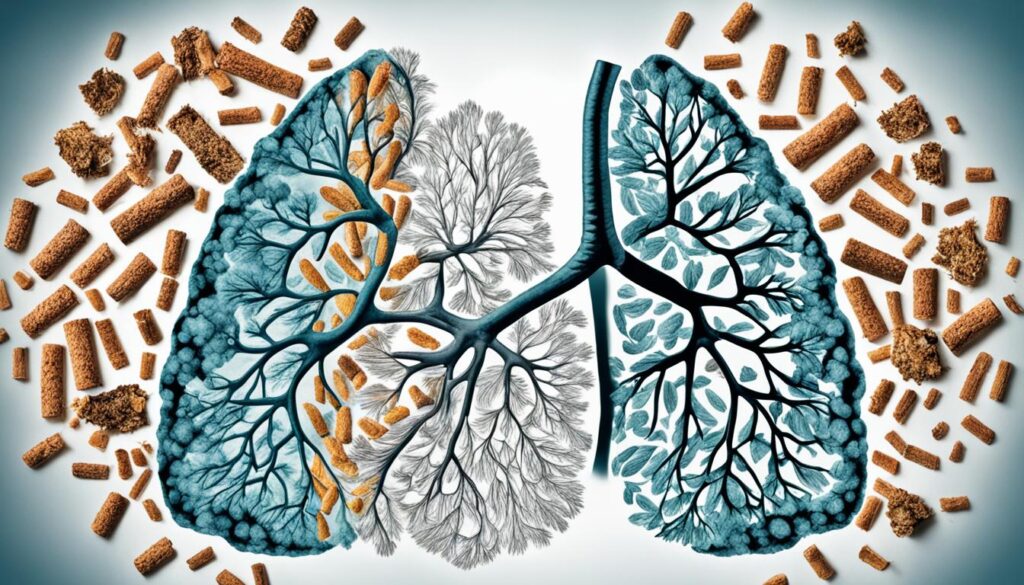I know how hard it is to quit smoking. Cigarettes can be really tempting, but quitting is possible and it changes your life for the better. In this guide, I’ll share strategies and techniques that helped me and many others live without cigarettes.
Smoking is a tough habit that affects both your body and mind. To quit, we need to tackle these issues directly. This article will cover proven methods that help smokers quit and stay smoke-free.
Key Takeaways
- Understand the mechanisms of nicotine addiction and its profound effects on the body and mind.
- Develop a personalized quit plan with specific strategies to manage cravings and triggers.
- Explore nicotine replacement therapy and prescription medications as tools to aid the quitting process.
- Implement lifestyle changes, such as dietary adjustments and exercise, to support your smoke-free journey.
- Leverage support systems, including family, friends, and professional resources, to stay motivated and accountable.
Understanding the Addiction
Nicotine addiction is more than just physical dependence. It’s important to understand its complex nature to overcome it. By looking at both the physical and mental sides, we can help smokers start a tobacco-free life.
Nicotine’s Grip and Its Effects
Nicotine is very addictive and makes the brain release dopamine, which feels good. This makes people want more nicotine, making it hard to stop. Nicotine addiction harms both the brain and body, leading to health issues like heart disease and breathing problems.
Psychological and Behavioral Factors
- Smoking can become a part of daily life, helping with stress, boredom, or social situations.
- It becomes a habit, with the action and feelings it brings making it harder to stop.
- Things like anxiety, depression, or not knowing how to cope make quitting nicotine addiction tough.
Understanding nicotine addiction is key to beating it. Knowing the physical and mental sides helps smokers face the challenges and move to a tobacco-free lifestyle.
“Quitting smoking is one of the most important things you can do for your health. It’s not easy, but it’s worth it.”
Preparing for the Journey
Quitting smoking is a big step, but with the right plan, you can do it. Start by setting a realistic quit date. Choose a date that means something to you, giving you time to get ready for a smoke-free life.
Setting a Quit Date
Think about these things when picking your quit date:
- Avoid quitting during stressful times, as it can make it harder.
- Choose a date that lets you celebrate big events smoke-free.
- Make sure you have enough time to get smoking cessation aids and plan how to handle smoking triggers.
Identifying Triggers and Coping Strategies
Knowing what makes you smoke is key to stopping. Take time to think about when and why you smoke. Once you know, make a plan to deal with those situations without smoking.
This might mean:
- Using stress-reducing methods, like deep breathing or meditation.
- Trying healthy alternatives, like gum or water, to keep your hands busy.
- Staying away from smoking friends or places where people smoke.
With a clear quit date and strategies for your triggers, you’re ready for a successful quit smoking journey.

Nicotine Replacement Therapy (NRT)
Quitting smoking is tough, but nicotine replacement therapy (NRT) can help. Products like patches, gum, and lozenges ease withdrawal symptoms. This makes quitting easier for those who want to stop smoking.
The main aim of nicotine replacement therapy is to give a steady, decreasing amount of nicotine. This helps the body get used to not having nicotine. Studies show that using NRT can double the chance of quitting for good.
For smoking cessation aids, NRT offers many choices. Nicotine patches give a steady dose all day. Gum and lozenges help with sudden cravings. There are different strengths and types to fit what each person needs.
| NRT Product | Delivery Method | Typical Use | Effectiveness |
|---|---|---|---|
| Nicotine Patch | Transdermal | Worn for 24 hours or while awake | Increases quit rates by 50-70% |
| Nicotine Gum | Oral | Used as needed for cravings | Increases quit rates by 30-50% |
| Nicotine Lozenge | Oral | Used as needed for cravings | Increases quit rates by 30-50% |
Nicotine replacement therapy is very effective when used with a full plan to quit. This plan might include counseling, support groups, and changing your lifestyle. Using NRT with these methods can greatly increase your chances of quitting for good.

Prescription Medications for Smoking Cessation
Quitting smoking is tough, but prescription drugs have made it easier for many. Two key medications, varenicline and bupropion, are widely used and effective.
Varenicline and Bupropion
Varenicline reduces nicotine’s pleasurable effects and helps with withdrawal symptoms. It targets nicotine receptors in the brain to lessen cravings. Studies show it can make quitting up to four times more likely than a placebo.
Bupropion is an antidepressant also used to help quit smoking. It cuts down nicotine cravings and withdrawal symptoms. It’s been shown to double the chances of quitting successfully compared to a placebo.
Consulting with a Healthcare Professional
Before starting any quit-smoking medication, talk to a healthcare professional. They can look at your health history and recommend the best treatment. They’ll guide you on how to use the medication safely, including dosage and side effects.
Working with a healthcare professional boosts your chances of beating nicotine addiction and staying smoke-free.

quit smoking, smoking cessation, nicotine addiction, stop smoking, tobacco-free
Starting to quit smoking and living without tobacco is tough but rewarding. This part talks about many strategies to beat nicotine addiction and stop smoking for good.
You might like a slow, step-by-step way or a quick “cold turkey” method. The main thing is to find what works best for you. There are many options like nicotine replacement, medicines, changing your lifestyle, and getting support to help you quit smoking, stop smoking, and achieve smoking cessation.
Remember, quitting is different for everyone. What helps one person might not help another. It’s key to keep an open mind, try different smoking cessation methods, and change your plan if needed.
“The secret of getting ahead is getting started. The secret of getting started is breaking your complex, overwhelming tasks into small, manageable tasks, and then starting on the first one.” – Mark Twain
Understanding nicotine addiction and your personal triggers helps you make a good plan to quit smoking. With determination, support, and trying different ways, you can beat nicotine addiction. This leads to a healthier, tobacco-free life.

Quitting smoking is hard, but it’s a journey worth it. With the right strategies and a commitment to your health, you can overcome the hurdles. You can live a life free from the limits of tobacco.
Cold Turkey: Quitting Without Aids
Quitting smoking is tough, and some people choose to stop without help. This method, called “cold turkey,” has its own set of challenges and benefits. It’s for those who want to be smoke-free without using aids.
The Benefits and Challenges
Going smoking cold turkey means you don’t need nicotine therapy or drugs. It’s good for those who like a natural way to quit or don’t want to deal with side effects. But, you’ll have to face nicotine withdrawal symptoms like feeling irritable, anxious, and having strong cravings.
Willpower and Determination
To quit cold turkey, you need a lot of willpower and determination. You must be ready to handle cravings and stress that might make you start smoking again. Using things like exercise, meditation, or therapy can help you stay on track with smoking cessation.
“Quitting smoking is the easiest thing in the world. I know because I’ve done it thousands of times.” – Mark Twain
Choosing to quit smoking cold turkey or using aids is a personal decision. Knowing the pros and cons helps you make a choice. Then, you can plan a way to reach your smoke-free goals.

Lifestyle Changes for a Smoke-Free Life
Quitting smoking is more than just wanting to stop. It’s about changing your whole life for the better. By making smart changes, you can boost your chances of quitting for good.
Dietary Adjustments
Eating right is key to helping you quit smoking. Eat more fruits, veggies, and whole grains to fight cravings and get the nutrients you need. Drinking lots of water also helps flush out toxins and eases withdrawal symptoms.
Exercise for a Healthier Life
Exercise is vital for a smoke-free life. Activities like walking, jogging, or swimming can reduce stress, lift your mood, and help with cravings. Exercise also releases endorphins, which ease nicotine withdrawal and help you stick to your quit plan.
| Dietary Changes | Exercise Benefits |
|---|---|
|
|
These changes will help you move towards a healthier, smoke-free life. Quitting smoking is a journey, and adding these good habits can make it easier. It can also help you stay smoke-free for the long term.

Support Systems and Resources
Quitting smoking is tough, but you’re not alone. Having a strong support system and using various resources can really help you quit. This can make your journey to a tobacco-free life much easier.
Family, Friends, and Support Groups
Telling your loved ones about your goal to quit smoking can really help. Ask them to support and keep you accountable. Join support groups online or in your area to meet others quitting smoking. Sharing stories and advice can keep you motivated and help you get through tough times.
Quit-Smoking Hotlines and Online Resources
There are many free resources out there to help you quit smoking. Look into quit-smoking hotlines for advice from experts. Check out online forums and websites for tips, strategies, and tobacco-free lifestyle info.
| Resource | Description | Contact Information |
|---|---|---|
| National Cancer Institute’s Smoking Quitline | Provides free, confidential support and information to help you quit smoking. | 1-877-44U-QUIT (1-877-448-7848) |
| Smokefree.gov | A comprehensive website with tips, tools, and resources to help you quit smoking. | www.smokefree.gov |
| American Lung Association’s Lung HelpLine | Offers support and information on quitting smoking and lung health. | 1-800-LUNG-USA (1-800-586-4872) |

You don’t have to go through quitting smoking alone. With the right support and resources, you can beat nicotine addiction and live a healthier, tobacco-free life.
Coping with Withdrawal Symptoms
Quitting smoking is tough, and nicotine withdrawal symptoms make it even harder. As your body gets used to not having nicotine, you might feel bad. But, with the right help and strategies, you can beat these challenges and become smoke-free.
Feeling irritable is a common issue when quitting. You might get easily annoyed or snappy with others. To deal with this, try relaxing activities like deep breathing, meditation, or a walk. These can calm your mind and body.
Anxiety and trouble focusing are also common when quitting. These can make everyday tasks hard. To fight this, think about trying cognitive-behavioral therapy or mindfulness. These can help you stay calm and focused.
Cravings and urges to smoke can be tough to handle. When you feel these urges, distract yourself with something healthy. Try drinking water, chewing gum, or calling a friend. Remember, these feelings will pass.
Staying positive and celebrating your small wins is key. Acknowledge your progress and don’t be too tough on yourself if you make mistakes. Quitting smoking is a journey, and it’s okay to have setbacks.
Dealing with nicotine withdrawal symptoms requires a mix of strategies and support. By trying different methods, getting help, and staying determined, you can overcome this challenge. You’ll become a healthier, happier, and smoke-free person.
“The greatest weapon against stress is our ability to choose one thought over another.” – William James

Relapse Prevention Strategies
Staying smoke-free is a lifelong journey. It’s important to keep moving forward. Knowing your smoking triggers and how to handle them is key. This helps you avoid going back to smoking.
Identifying Triggers and Avoiding Them
First, figure out what makes you want to smoke again. This could be stress, being around other smokers, or feeling bored. Knowing these smoking triggers helps you plan how to deal with them.
- Keep a journal to track your triggers and the situations they happen in.
- Avoid places or activities linked to smoking, especially when you’re trying to quit.
- Have a plan for when you feel the urge to smoke, like taking deep breaths or calling a friend.
Developing Coping Mechanisms
It’s also vital to find new ways to handle stress and boredom. These new habits can help you stay smoke-free. Here are some ideas:
- Try regular physical activities like walking or yoga to reduce stress and improve your mood.
- Use relaxation methods such as meditation or deep breathing to calm your mind.
- Get support from family, join a quit smoking group, or talk to a counselor for help.
Staying smoke-free takes hard work and dedication. But with the right strategies and support, you can beat the urge to smoke. Enjoy the many benefits of living a tobacco-free life.

“The key to successful relapse prevention is to anticipate and plan for potential challenges, rather than waiting for them to occur.” – Dr. Jane Doe, Smoking Cessation Expert
Celebrating Milestones and Staying Motivated
Starting to quit smoking is a big step, and it’s key to celebrate your wins along the way. Every day, week, or month you stay smoke-free shows your hard work and dedication. Acknowledge your progress and the good changes you’ve seen. These small wins will keep you motivated and inspired to keep going.
Creating a visual aid can help you stay on track. Think about making a “quit smoking” calendar. Mark the days, weeks, or months you’ve been tobacco-free. Seeing the count grow will remind you of how far you’ve come and your progress.
- Celebrate small wins, like reaching a smoke-free week or month.
- Treat yourself to something special, like a favorite meal or activity, as a reward for your accomplishments.
- Share your journey with supportive friends and family, and let them celebrate your milestones with you.
Remember, quitting quit smoking brings personal growth and health benefits. You might notice better lung function, more energy, and a lower risk of health problems. Embrace these positive changes and let them help you stay on track with your tobacco-free lifestyle.
“Quitting smoking is not easy, but it is possible. Celebrate your successes, and don’t be discouraged by setbacks. Each day smoke-free is a victory worth recognizing.”
It can be tough to stay motivated in your smoking cessation journey. But with the right mindset and strategies, you can beat challenges and become a confident, smoke-free person. Keep celebrating your progress and focus on the bright future ahead in a tobacco-free life.
The Long-Term Benefits of a Tobacco-Free Life
Quitting smoking is a big step that changes your life for the better. It leads to better health and happiness. By stopping tobacco use, you start a path to a healthier, more joyful life.
Improved Health and Well-Being
Right after you quit smoking, your body starts to heal. The risk of getting lung cancer and heart disease goes down. Your lungs and breathing get better.
You’ll feel more energetic, sleep better, and have a stronger immune system. This means a better quality of life overall.
Financial Savings and Personal Growth
Quitting smoking saves you a lot of money. You can use that money for things you really want, like saving for the future or enjoying hobbies. Or, you can treat yourself to new experiences.
Feeling good about quitting and being tobacco-free can make you more confident. It opens doors to new chances for you to grow personally.







Leave feedback about this